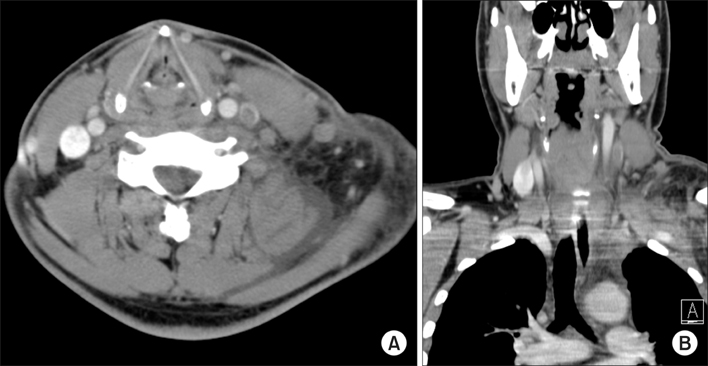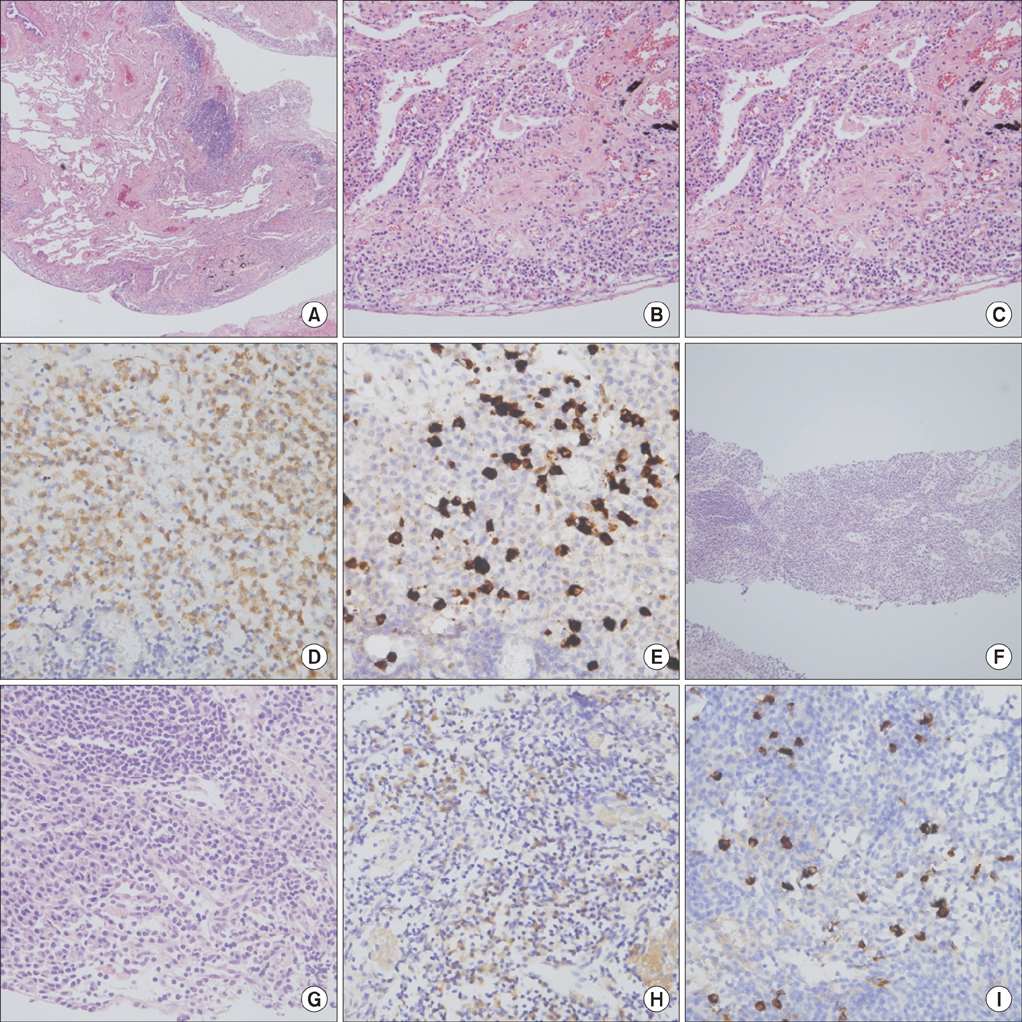Tuberc Respir Dis.
2014 Apr;76(4):179-183.
A Case of IgG4-Related Disease Presenting as Massive Pleural Effusion and Thrombophlebitis
- Affiliations
-
- 1Division of Respiratory and Critical Care Medicine, Department of Internal Medicine, Korea University College of Medicine, Seoul, Korea. minkyunghoon@korea.ac.kr
Abstract
- Immunoglobulin (Ig) G4-related disease is a recently recognized systemic fibroinflammatory condition characterized by a lymphoplasmacytic infiltrate rich in IgG4-positive plasma cells with elevated circulating levels of IgG4. The disease can either be localized to one or two organs, or present as diffuse multi-organ disease. Furthermore, lesions in different organs can present simultaneously or metachronously. In the pulmonary manefestations, lesions associated with IgG4-related disease have been described in the lung parenchyma, airways and pleura, as well as the mediastinum. We report a case of IgG4-related disease presenting as massive pleural effusion and thrombophlebitis.
Keyword
MeSH Terms
Figure
Reference
-
1. Saeki T, Saito A, Hiura T, Yamazaki H, Emura I, Ueno M, et al. Lymphoplasmacytic infiltration of multiple organs with immunoreactivity for IgG4: IgG4-related systemic disease. Intern Med. 2006; 45:163–167.2. Ryu JH, Sekiguchi H, Yi ES. Pulmonary manifestations of immunoglobulin G4-related sclerosing disease. Eur Respir J. 2012; 39:180–186.3. Sarles H, Sarles JC, Muratore R, Guien C. Chronic inflammatory sclerosis of the pancreas-an autonomous pancreatic disease? Am J Dig Dis. 1961; 6:688–698.4. Hamano H, Kawa S, Horiuchi A, Unno H, Furuya N, Akamatsu T, et al. High serum IgG4 concentrations in patients with sclerosing pancreatitis. N Engl J Med. 2001; 344:732–738.5. Kamisawa T, Funata N, Hayashi Y, Eishi Y, Koike M, Tsuruta K, et al. A new clinicopathological entity of IgG4-related autoimmune disease. J Gastroenterol. 2003; 38:982–984.6. Umehara H, Okazaki K, Masaki Y, Kawano M, Yamamoto M, Saeki T, et al. Comprehensive diagnostic criteria for IgG4-related disease (IgG4-RD), 2011. Mod Rheumatol. 2012; 22:21–30.7. Deshpande V, Zen Y, Chan JK, Yi EE, Sato Y, Yoshino T, et al. Consensus statement on the pathology of IgG4-related disease. Mod Pathol. 2012; 25:1181–1192.8. Masaki Y, Kurose N, Yamamoto M, Takahashi H, Saeki T, Azumi A, et al. Cutoff values of serum IgG4 and histopathological IgG4+ plasma cells for diagnosis of patients with IgG4-related disease. Int J Rheumatol. 2012; 2012:580814.9. Zen Y, Inoue D, Kitao A, Onodera M, Abo H, Miyayama S, et al. IgG4-related lung and pleural disease: a clinicopathologic study of 21 cases. Am J Surg Pathol. 2009; 33:1886–1893.10. Matsui S, Hebisawa A, Sakai F, Yamamoto H, Terasaki Y, Kurihara Y, et al. Immunoglobulin G4-related lung disease: clinicoradiological and pathological features. Respirology. 2013; 18:480–487.11. Kawakami N, Kawai K, Baba N, Ohshima K, Kanekura T. Immunoglobulin G4-positive multi-organ lymphoproliferative syndrome with antiphospholipid antibody syndrome. J Dermatol. 2012; 39:636–639.12. Tanigawa J, Daimon M, Murai M, Katsumata T, Tsuji M, Ishizaka N. Immunoglobulin G4-related coronary periarteritis in a patient presenting with myocardial ischemia. Hum Pathol. 2012; 43:1131–1134.13. Byeon K, Han J, Kim JS, Kim WS, Choe YH, Lee EJ, et al. Immunoglobulin G4-related periaortitis mimicking an intramural hematoma. Ann Thorac Surg. 2011; 92:1506–1508.14. Chari ST, Smyrk TC, Levy MJ, Topazian MD, Takahashi N, Zhang L, et al. Diagnosis of autoimmune pancreatitis: the Mayo Clinic experience. Clin Gastroenterol Hepatol. 2006; 4:1010–1016.15. Khosroshahi A, Carruthers MN, Deshpande V, Unizony S, Bloch DB, Stone JH. Rituximab for the treatment of IgG4-related disease: lessons from 10 consecutive patients. Medicine (Baltimore). 2012; 91:57–66.
- Full Text Links
- Actions
-
Cited
- CITED
-
- Close
- Share
- Similar articles
-
- A Case of Extensive IgG4-Related Disease Presenting as Massive Pleural Effusion, Mediastinal Mass, and Mesenteric Lymphadenopathy in a 16-Year-Old Male
- A Case of Chronic Pancreatitis with Massive Pleural Effusion
- Refractory Pleural Effusion in Systemic Lupus Erythematosus Treated by Pleurectomy
- Non-IgG4-Related Fibrosclerosing Periaortitis with Multisystemic Involvement
- A Case of Ovarian Hyperstimulation Syndrome with Massive Pleural Effusion




